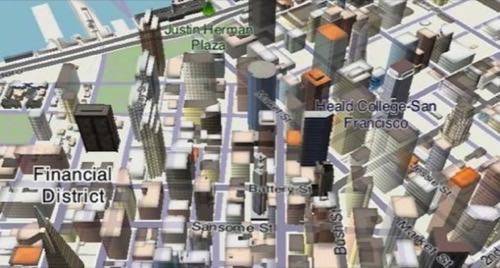
UpNext Maps for iPhone is beautiful. It’s the smoothest, fastest map I’ve ever used. It renders 3D buildings for virtual exploration of certain cities. Its look and functionality are distinctive. It’s free. And both Google and Apple want to build these features themselves. Is this a kamikaze mission for UpNext?
“We’ve been hobbyists in maps since 2004,” says UpNext co-founder Raj Advani. “At the time, I was fond of coding video games, and the gulf in interactivity between the video game experience and the digital mapping experience was striking. A video game world is animated, alive, interactive; things can change. There are weather patterns, sunsets, noise and immersion. In the digital mapping world back then, there were just roads – and ugly, static roads at that.”
UpNext’s goal from the outset was to write a vector-based mapping engine. Traditional mapping systems, including Google, Bing and OpenStreetMap, are tile-based. They download whole pieces of the map as you need them. UpNext works more like a 3D gaming engine; it’s downloading raw data and then rendering the maps itself.
“The difference is key,” Advani says, “because being able to decide, in real time, how data is rendered is what makes vector maps so compelling. It enables a map to change in response to the actions and the environment of the user.”
The idea was ahead of its time in 2004, but now there are smart, fast mobile devices with lots of native computing power. Google Maps 5.0 for Android got vector-based maps in 2010, with similar tilting and 3D buildings, but UpNext Maps for iPhone has now gone further than that. It uses the dynamic nature of vector-based maps to adapt the map to the user’s wishes.
What Does UpNext Maps Do Differently?
For the user, UpNext Maps just feels nicer than the built-in map. Everything happens faster. It snaps into position smartly, so it’s impossible to lose your place, and it’s easy to tilt back and forth between 2D and 3D views. The 3D buildings – only available in some cities – took some time to load in my tests, but that didn’t take away from exploring the maps themselves or slow the process down.

UpNext focuses on what the user is doing. It shifts the colors and emphasis of the map based on what you’re searching for. If you’re looking for Italian restaurants, those glow, and the rest of the map fades out. If you tap a subway station, it animates actual trains and displays estimated arrival times. While the dominant map systems concentrate on roads, UpNext shifts to emphasize whatever information the user needs.
UpNext Maps for Android is coming soon. For iPhone users, UpNext ties in with VZ Navigator for turn-by-turn directions powered by Verizon. That service costs $4.99 per month, and Android users have turn-by-turn built into their phones. But until Apple offers its own turn-by-turn features, this combination with UpNext definitely outdoes the iPhone’s stock navigation options.
The key difference between built-in maps and UpNext is the toggle between “immerse” and “explore” modes. It’s not just a navigation tool like Google Maps, nor is it just a world-exploring tool like Google Earth. It’s just enough of both at once, and it performs better.
The app is not perfect. It doesn’t yet include much of the Earth, for one thing, but the U.S. is there. It has a pretty hard time finding places by search, whereas Google Maps figures out what you’re looking for almost every time. But as a way of browsing a map, UpNext has no peers. It tilts seamlessly from 2D to 3D, and you can turn the place-browsing layer on and off as needed. But the most amazing part is the performance. It loads so fast and scrolls so smoothly that Apple and Google look like novices in comparison.

Bootstrapped Maps
UpNext does have considerable experience behind it. Three of its four co-founders have experience building 3D graphics for games. Its founders have been working on maps since 2004 – before Google Maps launched – and formally founded UpNext in 2007. For four years, they forged ahead as a bootstrapped company until Chris Sacca came aboard as an angel investor a little more than a year ago.
Was that a crazy investment?
By now, Google seems to have maps well under control for the entire world, and Apple is known to be building its own maps, which will have to be even better than Google’s. Among Apple’s mapping acquisitions was C3 Technologies, which built eye-popping 3D maps that are sure to dazzle users of existing immersive maps, including UpNext. What keeps UpNext working on maps despite the risk of getting stepped on by one (or both) of the mobile platform titans?
A Dearth of Innovation
It was only a year after these four founders started making maps that Google released Google Maps. “Our fledgling project was already on the ropes,” Advani says. Google began to dominate, and investors began to run from mapping apps. All the VC money and press attention ran to social applications. “If you were working on ‘raw tech,’ you’d have a very difficult time raising money in this period,” says Advani.
Consequently, UpNext found itself with very little competition from startups. Apps that needed location would just build on the Google Maps API. Google Maps became “safe,” as Advani says. With all the attention on Google, UpNext kept building quietly.
“At some point,” says Advani, “after several near-death experiences, we became inured to this fear of being steamrolled. We began to believe that while Google could evolve, they just couldn’t be radical. That’s what’s kept us going.”
Google hasn’t stopped innovating on maps. Street View is a different kind of immersive experience than 3D. It’s a snapshot of the real place frozen in time but with photographic realism. Additionally, it has begun to push vector-mapping and indoor maps into the Android version and add more Google Earth integration for 3D experiences. But it has also started sewing up the business aspects of maps. That wonderful API upon which developers depended now costs money to use.
Maps is becoming a core business for Google, and that may be hurting its ubiquity and user experience. UpNext should be overjoyed about that. But there’s one problem, and it’s a little company called Apple, Inc.
Screenshot of C3 Technologies street view (via MacRumors)

Apple Maps: The Looming Shadow
We can pretty much bet on Apple revealing its new, Google-free maps at WWDC next month as part of iOS 6. Siri already asks Yelp for restaurants instead of Google, and now it will be able to give its own directions. And the 3D imagery acquired in the C3 Technologies deal will probably allow iOS users to forget about Google Street View. Where will that leave UpNext?
“We think C3 is the wrong direction,” Advani says. “It’s essentially an improved satellite view – satellite with a third dimension. We believe maps are about more than maximizing realism; they’re meant to be immersive and evocative.
“Think of an amusement park map: You look at it, and with just a glance, you get a feel for the different areas. Realism is not what we’re after. What we want to do is bring that old-school sense of wonder back to maps.”
Next month’s news will escalate the platform battle between Google and Apple over mapping, which is a crucial mobile feature. But UpNext is finding more investor interest than ever before. With Apple and Google so concerned with the business of mapping, UpNext has a chance to deliver a better experience.
Clarification 5/25 7:48 AM: The post was updated to clarify that Google Maps for Android has also moved to a vector-based map.










